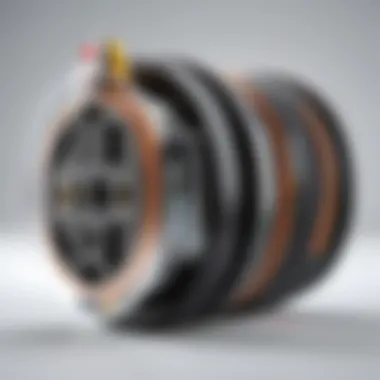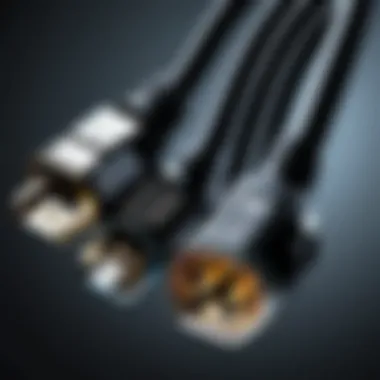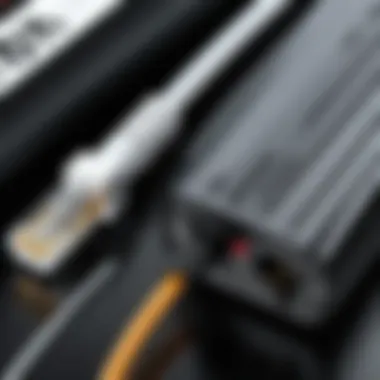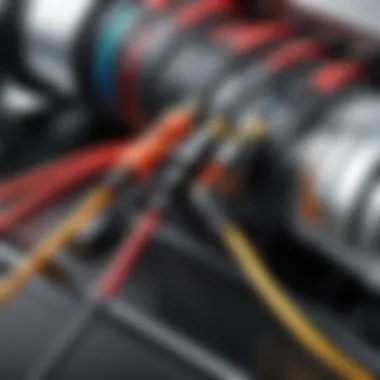Understanding the 100 ft 3 Prong Extension Cord


Intro
The 100 ft 3 prong extension cord is a vital tool in today's world, catering to various power demands in both households and workplaces. Its design balances utility with safety, accommodating a range of devices from simple home appliances to more complex equipment used in professional settings. Understanding its features, specifications, and suitable use cases can significantly enhance your experience and ensure you make the most efficient decisions.
This article aims to provide a comprehensive overview of the 100 ft 3 prong extension cord. By dissecting its technical specifications, practical applications, and safety considerations, we will equip you with the knowledge to navigate your power needs intelligently. Let us dive into the first essential aspect: technical specifications.
Technical Specifications
Detailed Product Specs
The 100 ft 3 prong extension cord is designed with certain key technical specifications that make it a reliable choice for various scenarios. The cord usually contains three wires: one for the live wire, another for the neutral wire, and the last for the ground. Its gauge rating is typically 12 or 14 gauges, which indicates the thickness of the wire and its ability to handle electrical current. A lower gauge number implies a thicker wire capable of carrying more power safely.
Performance Metrics
Performance metrics are critical when evaluating an extension cord. For the 100 ft extension cord, the following aspects are essential:
- Voltage Rating: Generally rated at 120 volts, suitable for standard household use.
- Amp Rating: It often carries 15 amps, which is adequate for most consumer electronics and appliances.
- Durability: The cord is usually made from a durable material, resistant to wear-and-tear, ensuring longevity even in demanding environments.
Compatibility Information
Compatibility with various devices should be assessed before purchasing an extension cord. The 100 ft 3 prong extension cord is versatile and works well with:
- Common household appliances like refrigerators, microwaves, and air conditioners.
- Power tools and equipment for workshops and construction sites.
- Audio and visual equipment, enabling flexibility in setups.
With these specifications laid out, it's clear that understanding the capabilities of a 100 ft 3 prong extension cord is crucial for maximizing its use. Next, we will explore practical applications that delineate how different users can leverage this tool effectively.
Prologue to Extension Cords
Extension cords are a fundamental component of electrical setups in various environments. They offer increased accessibility to power sources, allowing devices to be used far from wall outlets. Understanding the basic attributes of extension cords is vital for efficient and safe usage.
Definition and Purpose of Extension Cords
Extension cords serve as a means to connect electrical devices to a power source via flexible cables. These cords extend the reach of power, making them essential for both residential and commercial applications. They come in multiple lengths, including the popular 100 ft variation, and feature various configurations such as a three-prong design. This design allows for grounding, ensuring additional safety in operation. The primary purpose is to facilitate the use of power tools, lighting, appliances, and electronic devices in locations away from permanent outlets.
Historical Context of Extension Cords
The concept of extension cords has evolved over time. The earliest versions can be traced back to the increasing demand for electric power in homes and businesses during the late 19th and early 20th centuries. Initially, these cords were simple and lacked safety features. As technology advanced, so did the design and functionality of extension cords, leading to the introduction of improved insulation, grounding mechanisms, and standard safety regulations. The use of three-prong extension cords became common as a response to the growing awareness of electrical hazards. Today, extension cords are ubiquitous, appearing in endless settings from construction sites to home theaters. Understanding this evolution helps consumers appreciate the safety features and design considerations present in modern extension cords.
Overview of the ft Prong Extension Cord
The 100 ft 3 prong extension cord is a vital tool in modern electrical usage, offering both versatility and convenience for a wide range of applications. It serves as a link between power sources and devices located far apart. As electrical devices continue to expand in our daily lives, a reliable extension cord becomes essential. This section explores the inherent design features and technical specifications that define this cord, along with their implications for users.
Design Features
When looking at the design of the 100 ft 3 prong extension cord, a few key factors come into play. First, the length, which is exactly 100 feet, allows for significant reach, making it suitable for both indoor and outdoor use. The three prongs offer grounding, enhancing safety when using appliances that require more power. The cord is generally made from a robust and flexible material, often PVC, which resists damage and facilitates ease of handling. Users may also notice that it tends to be thicker compared to standard extension cords, which contributes to its durability.
Moreover, many cords have a bright-colored exterior that makes them visible, thereby reducing the risk of tripping or accidents. This design consideration is particularly useful in outdoor environments where visibility is crucial. The strain relief design at both ends also helps prevent cord fraying and damage, which is common in regular use.
Technical Specifications
Understanding the technical specifications of the 100 ft 3 prong extension cord is crucial for making informed purchasing decisions. Usually, these cords can handle various electrical loads, classified by amperage and wattage ratings. Most commonly, you will find cords rated for either 15 amps or 20 amps. The wattage can be calculated using the formula:
For your typical cord, this means a 15 amp cord can support appliances up to 1800 watts.
Another important specification involves the wire gauge, typically ranging from 12 to 16 AWG (American Wire Gauge). A lower gauge number indicates a thicker wire and therefore a higher capacity for handling power. A 12 AWG extension cord is better for high-demand appliances, while a 16 AWG cord is sufficient for smaller devices. Moreover, some cords may have additional features like weather resistance for outdoor usage, further enhancing their utility.
In summary, the design and technical specifications of the 100 ft 3 prong extension cord enable it to serve a wide range of needs. It provides a reliable solution for electrical access, combining durability with functionality to meet the diverse demands of users.
Application Scenarios
Application scenarios are critical when choosing the right extension cord. The 100 ft 3 prong extension cord serves various environments, from homes to commercial spaces. Understanding these scenarios helps consumers select the appropriate cord for their specific needs.
Residential Use


In residential settings, the 100 ft 3 prong extension cord offers flexibility and convenience. Homeowners often need to power tools in their garden or connect outdoor lights. Common applications include:
- Yard work: Electric lawn mowers and trimmers often require power well beyond typical outlets. A long extension cord allows movement across a larger area without relocating.
- Home improvement: While performing renovations, tools like drills or saws may need to reach distant outlets. This extension cord is ideal in such circumstances.
- Seasonal decor: For holidays, lights and electric decorations can spread across the yard or along rooftops without worrying about outlet limitations.
It is vital to assess the amp rating of devices used at home. This knowledge helps to avoid overloading the extension cord, which may lead to hazards.
Commercial Use
In commercial environments, the 100 ft 3 prong extension cord is invaluable. It meets the demands of various industries, such as construction, events, and retail. Its key applications are:
- Construction sites: Powering tools and equipment is common on sites where permanent power isn't available yet. This cord can service multiple tools simultaneously, enhancing productivity.
- Event setups: For fairs or trade shows, it provides temporary power to booths or displays. The cord's length helps reach power sources, regardless of setup layouts.
- Temporary installations: Businesses may require temporary lighting or equipment power during renovations or repairs. The extension cord effectively meets these temporary demand needs.
Using a quality extension cord is essential in commercial settings to ensure safety standards are met. It is also vital to consider factors like cord durability and weather resistance, especially for outdoor applications.
The right extension cord not only enhances convenience but also ensures safety and efficiency in powering tools and devices across various settings.
Safety Considerations
The importance of safety considerations cannot be overstated when discussing any electrical device, particularly extension cords. These cords, while incredibly useful for extending power, also present certain risks if not handled correctly. Understanding the safety aspect helps mitigate potential hazards, ensuring that users can maximize the benefits of their 100 ft 3 prong extension cord while minimizing risks.
Electrical Safety Standards
Electrical safety standards are a set of criteria designed to ensure that electrical devices operate safely without causing harm. For extension cords, standards are established by organizations such as the Underwriters Laboratories (UL) and the Institute of Electrical and Electronics Engineers (IEEE). When selecting a 100 ft 3 prong extension cord, ensure it meets these standards. Devices can be marked with certifications that verify compliance with safety benchmarks.
Safety standards affect the robustness of materials used in cord construction, the proper gauge for conductor wires, and the overall design. A certified extension cord usually has better insulation and reduced chances of overheating. Keeping abreast of these standards helps consumers make informed decisions, ensuring they do not compromise safety for price or aesthetics.
Common Hazards and Precautions
Using a 100 ft 3 prong extension cord involves several common hazards, most of which are preventable with simple precautions. Here are a few hazards to be aware of:
- Overheating: Long cords can be prone to overheating if overloaded.
- Damaged Insulation: Wear and tear can lead to frayed wires, exposing live electrical conductors.
- Outdoor Use Risks: Cords not rated for outdoor use can be susceptible to moisture damage.
- Precaution: Do not exceed the wattage rating specified by the manufacturer.
- Precaution: Regularly inspect cords for damage before each use and replace if necessary.
- Precaution: Use extension cords specifically labeled for outdoor environments.
Important: Always unplug cords when not in use to prevent possible electrical fires.
Types of ft Prong Extension Cords
Understanding the types of 100 ft 3 prong extension cords is crucial for consumers. Different tasks require specific types of cords for optimal performance. Knowing these types allows users to make informed choices. Selecting the right cord depends on the expected use, power requirements, and safety features.
Heavy-Duty Extension Cords
Heavy-duty extension cords are designed for demanding tasks. They typically contain thicker wires, which allows more current flow. This type is suitable for high wattage equipment, such as power tools, large appliances, or outdoor machinery. Users often select heavy-duty cords for construction sites or outdoor work.
Key Features:
- Wire Gauge: Heavier gauge wires (lower AWG numbers) reduce voltage drop. Common gauges for heavy-duty cords include 12 or 10 AWG.
- Durability: Often insulated with thick rubber or PVC, these cords withstand wear and tear. They are also less likely to kink.
- Weather Resistance: Many heavy-duty options are weatherproof, making them ideal for outdoor conditions.
Benefits:
- High Performance: They can support high-load appliances without overheating.
- Versatility: These cords work well in both indoor and outdoor environments, making them a versatile choice.
- Safety: Built-in circuit breakers in some models prevent overloads, enhancing safety.
Choosing a heavy-duty extension cord ensures you can use power-hungry tools without risk of damage or safety hazards.
Light-Duty Extension Cords
Light-duty extension cords are meant for less demanding applications. These cords typically have thinner wires and are ideal for lower power devices. They often serve well for indoor use, powering smaller appliances or electronics like lamps and computer equipment.
Key Features:
- Wire Gauge: Thinner gauge wires (higher AWG numbers). Commonly found in 16 or 18 AWG.
- Flexibility: These cords are lightweight, making them easy to move and store.
- Affordability: Generally more affordable than heavy-duty alternatives due to simpler construction.


Benefits:
- Ideal for Home Use: Perfect for everyday electronics that require low power.
- Easier to Handle: Their lightweight nature allows for easy transportation and setup.
- Short-term Use: Good for temporary setups, like outdoor gatherings.
In summary, knowing the types of 100 ft 3 prong extension cords helps consumers choose the right product for their needs. Heavy-duty cords serve well for high power applications, while light-duty cords cater to smaller devices. Each type offers unique benefits, making it essential to evaluate demands before purchasing.
Comparative Analysis
The comparative analysis of extension cords is crucial for understanding their varied functionalities and applications. In this section, we will highlight how different types of cords cater to specific needs. This analysis enables consumers to discern which cord best fits their requirements, considering factors such as distance, power supply, and usability.
ft Prong vs.
Shorter Extension Cords
Choosing between a 100 ft 3 prong extension cord and shorter options often comes down to distance and power needs. A 100 ft cord enables flexibility in reaching distant outlets without the need for multiple connections. This can be particularly advantageous in situations like outdoor events or construction sites, where power sources may be limited.
Benefits of a ft Cord:
- Extended Reach: Capable of covering larger areas effortlessly.
- Reduced Voltage Drop: At proper voltage ratings, these cords help minimize power loss over distance.
- Versatility: Suitable for various equipment, allowing for diverse applications.
Shorter extension cords, on the other hand, are beneficial in confined spaces where high power demand isn’t a concern. They are easier to manage and usually lighter, making them ideal for simpler tasks like charging devices in a small room or powering indoor appliances.
Considerations for Shorter Cords:
- Convenience: Easier to store and move around.
- Less Clutter: Reduces the risk of tangling and tripping hazards.
- Lower Power Demand: Works well for small electronics lightweight devices.
ft Prong vs.
Multi-Outlet Power Strips
When comparing a 100 ft 3 prong extension cord to multi-outlet power strips, the key lies in the nature of power supply needed. A power strip offers multiple outlets but is usually limited to a shorter range.
Advantages of the ft Prong Cord:
- Powering High-Demand Equipment: Ideal for tools or devices that require more power.
- Single Connection: Reduces risks associated with multiple connections and potential overloads.
- Durability: Designed to handle heavier loads without degradation.
In contrast, multi-outlet power strips are practical for scenarios where many devices require power at once, but may lack the robustness needed for high-draw devices. Often, their wattage limits can be restrictive, making them less suitable for demanding applications.
Drawbacks of Power Strips:
- Overload Risk: Connecting too many devices can lead to tripped breakers.
- Limited Range: Typically shorter, reducing overall effectiveness for remote applications.
- Weight Restrictions: Not always designed to handle heavier equipment.
“Understanding the differences between a 100 ft extension cord and other power solutions is essential for efficient power management in different settings.”
Tips for Selection
Selecting the right extension cord is crucial for ensuring optimal performance and safety. When it comes to a 100 ft 3 prong extension cord, various factors can influence your decision. Understanding your specific needs can lead to better choices and effective use of power supply.
Assessing Your Power Needs
Before purchasing an extension cord, you must evaluate your power requirements. Consider the devices you plan to connect and their wattage. For instance, if you intend to power a high-wattage appliance like a space heater, ensure the cord can handle the load. A typical rule is to add up the wattage of all devices you will use simultaneously.
- Power Ratings: Devices often come with labels indicating their wattage. Check these carefully.
- Cord’s Ampacity: Know the amp rating of the cord to ensure it can handle your device’s demand. A safe choice for most appliances is at least a 15-amp cord.
Identifying Quality Cords
After you establish your power needs, the next step is to choose a quality extension cord. Not all cords are created equal; thus, you should examine several key factors:
- Wire Gauge: Cords with a lower gauge number (e.g., 12-gauge) can handle more current than those with a higher number (e.g., 16-gauge).
- Material: Look for cords made of durable materials, like rubber or heavy-duty plastic, which can resist wear and environmental exposure.
- Certifications: Always check for certifications such as UL (Underwriters Laboratories) to ensure safety and reliability.
Maintenance of Extension Cords
Maintenance of extension cords is crucial to ensure their longevity, reliability, and safety. A well-maintained extension cord can prevent electrical hazards, ensure efficient power delivery, and reduce the risk of fire. Regular checks and care can also assist in identifying potential problems before they become significant issues.
Best Practices for Care


To maintain your 100 ft 3 prong extension cord effectively, follow these best practices:
- Inspect Regularly: Check your cord for any signs of damage, such as frayed wires or exposed insulation. Regular inspections can catch problems early.
- Store Properly: Avoid leaving cords exposed to extremes of temperature or moisture. Wind them neatly to prevent kinks that could cause damage.
- Avoid Overloading: Make sure not to exceed the cord's power capacity. Refer to the specifications to understand the maximum load.
- Keep Dry: Ensure the cord remains dry. Moisture can lead to short circuits and other issues.
- Use as Intended: Only use extension cords for their intended purpose, whether for indoor or outdoor use. This can mitigate risks associated with misuse.
Signs of Wear and Tear
Recognizing the signs of wear and tear on your extension cord is vital for maintaining its integrity. Some indicators that your cord may need replacing include:
- Frayed or Exposed Wires: If you see any wires peeking through the insulation, the cord is unsafe to use.
- Brittle or Cracked Insulation: Insulation should be flexible. Any signs of brittleness could indicate that the cord is no longer reliable.
- Burn Marks or Odors: Any signs of scorching or burning are serious and require immediate attention.
- Unusual Heat: If the cord becomes unusually warm during use, it may suggest that it's overloaded or damaged.
Regular maintenance and careful observation of your extension cord can significantly enhance safety and performance.
Environmental Considerations
The environmental impact of extension cords deserves careful attention. As technology advances, the usage of extension cords has increased in both residential and commercial settings. Recognizing the implications on the environment is critical for consumers and manufacturers alike.
Sustainability of Extension Cords
Sustainable practices regarding extension cords can significantly reduce environmental strain. Choosing high-quality, durable extension cords is a simple step toward sustainability. These cords often last longer, reducing the need for replacements.
Environmental benefits include decreased waste, as fewer cords end up in landfills. Additionally, selecting cords made from recyclable materials can further benefit sustainability efforts.
Improper disposal of extension cords can lead to hazardous waste. This contributes to soil and water contamination, affecting both ecosystems and human health.
Recycling Old Extension Cords
Recycling old or damaged extension cords is an effective way to mitigate environmental harm. Many components of these cords can be repurposed or recycled. Metals and plastics can often be separated and processed by recycling centers.
Here are some options for recycling:
- Local Recycling Programs: Check with your local waste management authorities for proper disposal methods.
- Electronic Collection Events: Many communities host events for electronic waste. These are excellent opportunities to recycle extension cords.
- Mail-in Programs: Certain companies provide mail-in recycling options for electronic and electrical items.
Proper disposal and recycling not only declutter homes but also supports a healthier planet.
Ending
In this article, we have delved into the multifaceted nature of the 100 ft 3 prong extension cord. Understanding its design, functionality, and applications is crucial for anyone who engages with electrical devices, be it in home settings or professional environments. Selecting the right extension cord can make a significant difference in ensuring safety, efficiency, and convenience during use.
Final Thoughts on ft Prong Extension Cords
The 100 ft 3 prong extension cord is more than just a length of wire; it serves as a conduit for power delivery in various situations. Its versatility allows it to cater to both residential and commercial needs. With a suitable choice, users can power tools, lights, and appliances that may be situated far from outlets.
Remember, the right cord not only enhances efficiency but also promotes safety.
Recognizing the distinction between heavy-duty and light-duty options is vital. Users should consider their power requirements carefully. Furthermore, practicing proper care and maintaining these cords can prolong their life and reduce hazards. Paying attention to environmental considerations like sustainability and recycling is also essential in our increasingly eco-conscious world.
In summary, this article has informed you about various aspects of the 100 ft 3 prong extension cord, ensuring that you are equipped with the knowledge necessary to make educated choices. Whether for personal or professional use, understanding the features and applications of these cords will contribute to smarter decisions in your daily activities.
Frequently Asked Questions
Frequently asked questions serve as a critical component in this discussion on the 100 ft 3 prong extension cord. This section aims to address common concerns, clarify doubts, and dispel myths related to extension cords. By answering these questions, we foster a better understanding of the product. This helps users to use them safely and effectively.
Benefits of FAQs
- Provides Clarity: They help clarify technical specifications, limitations, and best practices.
- Enhances Safety: Addressing safety concerns directly can reduce the risk of accidents.
- Saves Time: Users can quickly find solutions to their problems without sifting through long articles.
- Improves User Experience: A well-informed consumer feels more confident in their choices, enhancing their overall experience when using extension cords.
Considerations should include the understanding of different applications, variations in quality, and the cord's overall capacity to handle electrical loads under various conditions. With these answers, individuals can make informed decisions, maximizing efficiency for their specific power needs.
Common Queries Related to ft Extension Cords
When looking into 100 ft extension cords, various aspects are frequently questioned. Here are some common queries:
- What are the best uses for a 100 ft extension cord?
- Is a 100 ft extension cord suitable for heavy appliances?
- Can multiple extension cords be used together?
- How do I store my 100 ft extension cord properly?
- What should I look for in terms of safety ratings?
- Ideal for powering equipment in gardens, outdoor events, and workshops due to its extended reach.
- Yes, but it's essential to choose a heavy-duty cord rated for the necessary load to prevent overheating.
- It is generally not recommended as this increases the risk of voltage drop and may lead to hazards.
- Coiling the cord neatly and avoiding knots can prolong its lifespan and prevent damage.
- Look for cords that meet or exceed relevant electrical safety standards.
These queries highlight key areas of interest and concern for users, assisting in making educated decisions about the usage and selection of 100 ft extension cords.







